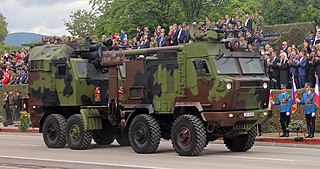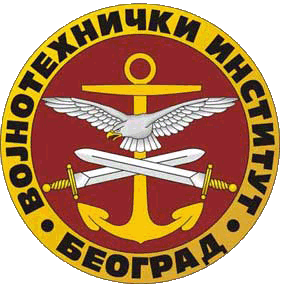
The M102 is a light, towable 105 mm howitzer used by the United States Army in the Vietnam War, the First Gulf War, and the Iraq War.

The M114 is a towed howitzer developed and used by the United States Army. It was first produced in 1942 as a medium artillery piece under the designation of 155 mm Howitzer M1. It saw service with the US Army during World War II, the Korean War, and the Vietnam War, before being replaced by the M198 howitzer.

The M-84 is a Yugoslav main battle tank, a variant of the Soviet T-72 tank. The M-84 is still in service in Croatia, Serbia, Bosnia and Herzegovina, Slovenia and Kuwait.

The M101A1 howitzer is an artillery piece developed and used by the United States. It was the standard U.S. light field howitzer in World War II and saw action in both the European and Pacific theaters and during the Korean War. Entering production in 1941, it quickly gained a reputation for accuracy and a powerful punch. The M101A1 fires 105 mm high explosive (HE) semi-fixed ammunition and has a range of 12,330 yards (11,270 m), making it suitable for supporting infantry.

The 122 mm howitzer M1938 (M-30) is a Soviet 121.92 mm (4.8 inch) howitzer. The weapon was developed by the design bureau of Motovilikha Plants, headed by F. F. Petrov, in the late 1930s, and was in production from 1939 to 1955. The M-30 saw action in World War II, mainly as a divisional artillery piece of the Red Army (RKKA). Captured guns were also employed later in the conflict by the German Wehrmacht and the Finnish Army. Post World War II the M-30 saw combat in numerous conflicts of the mid- to late twentieth century in service of other countries' armies, notably in the Middle East.

The OTO-Melara Mod 56 is an Italian-made 105 mm pack howitzer built and developed by OTO Melara. It fires the standard US type M1 ammunition.

Gun howitzer NORA is a Yugoslav and Serbian 152mm and 155mm gun-howitzer developed by the Military Technical Institute (MTI) for the Yugoslav People's Army, Serbian Army, and export. Gun howitzer NORA has three basic versions, and is usually towed by a FAP 2026 BS/AV truck.

The 152 mm gun-howitzer M1955, also known as the D-20, is a manually loaded, towed 152 mm gun-howitzer artillery piece, manufactured in the Soviet Union during the 1950s. It was first observed by the west in 1955, at which time it was designated the M1955. Its GRAU index is 52-P-546.

The Nora B-52 is a 155 mm self-propelled howitzer developed by Military Technical Institute and manufactured by Yugoimport SDPR in Velika Plana, Serbia.

The BVP M-80, is a tracked Yugoslavian-made infantry fighting vehicle, produced from the 1980s until the country's collapse in the 1990s.

The Yugoslav Ground Forces was the ground forces branch of the Yugoslav People's Army (JNA) from 1 March 1945 until 20 May 1992 when the last remaining remnants were merged into the Ground Forces of the new Federal Republic of Yugoslavia, under the threat of sanctions.
The Zastava M02 Coyote is a 12.7mm heavy machine gun produced by Zastava Arms. The M02 is very similar to the NSV machine gun and Kord machine gun in appearance and capability. The M02 can fire over 700 rounds per minute and has a maximum effective range of 2,000 m against ground targets and 1,500 m against airborne targets.

Military Technical Institute is a Serbian weapons and aircraft design institute, headquartered in Belgrade, and governed by the Serbian Ministry of Defence. It is a top-level military scientific research institution in Serbia, dealing with research and development (R&D) of new weaponry and military equipment as well as with upgrade of the inventory for both branches of the Serbian Armed Forces: Army and Air Force and Defence.
The M74 mortar is designed by Military Technical Institute in Yugoslavia. It is smooth bore, muzzle-loading, high-angle-of-fire weapon used for long-range indirect fire support. Today they are produced by Serbian company PPT Namenska and BNT from Bosnia and Herzegovina.

The Zastava CZ99 is a semi-automatic pistol produced by Zastava Arms. It was developed in 1989 to replace the M57 in the Yugoslav military and police. The CZ99 is primarily chambered in 9×19mm Parabellum with a 15-round magazine, although .40 Smith & Wesson variants also exist, with ten-round magazines.
105 mm is a common NATO-standard artillery and tank gun calibre. The rifled tank round is defined by STANAG 4458. The artillery round is defined by AOP-29 part 3 with reference to STANAG 4425.

The Zastava NTV is a Serbian 4x4, multipurpose, all-terrain infantry mobility vehicle designed by the Military Technical Institute and Zastava Trucks, and manufactured by Zastava TERVO. The primary users are the Serbian Armed Forces; the vehicle may also be offered for the export market.

The KH178 is a South Korean 105 mm 38 caliber towed howitzer. It was designed and developed by the Agency for Defense Development for the Republic of Korea Armed Forces and manufactured by Hyundai WIA.



















